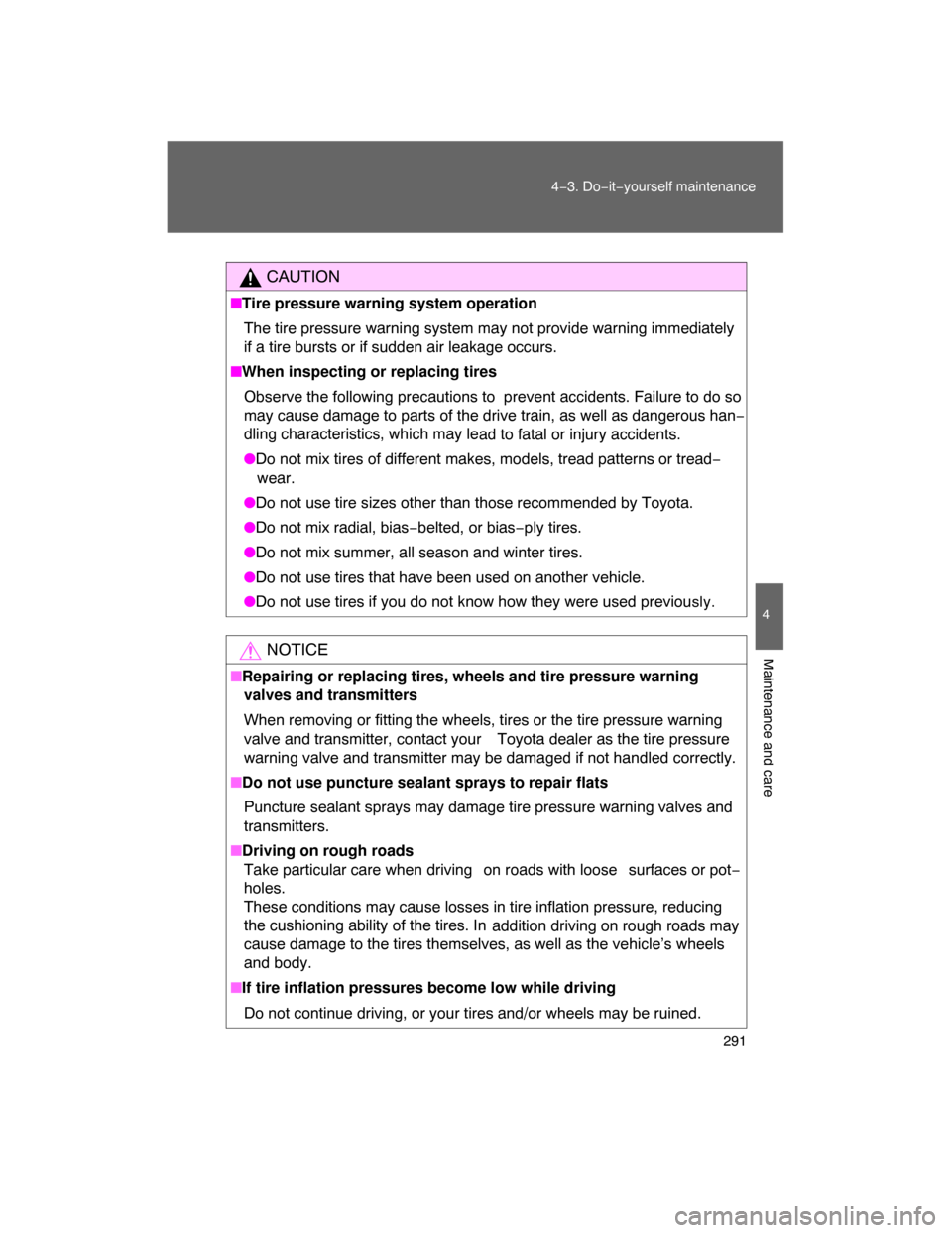Page 185 of 400
188 3−1. Using the air conditioning system and defogger
Right and left side outlets
Direct air flow to the left or right,
up or down.
Opening and closing the right and left side outlets
Open the vent.
Close the vent.
Page 186 of 400

189
3−1. Using the air conditioning system and defogger
3
Interior features
� Using the system in recirculated air mode
The windows will fog up more easily if the recirculated air mode is used for
an extended period.
� When outside air temperature approaches 32�F (0�C)
The air conditioning system may not operate even when
is pressed.
� When
is selected for the air outlets used
For your driving comfort, air flowing to the feet may be warmer than air flow−
ing to the upper body depending on the position of the temperature adjust−
ment dial.
CAUTION
� To prevent the windshield from fogging up
Do not set the air outlet selection dial to during cool air operation in
extremely humid weather. The difference between the temperature of the
outside air and that of the windshield can cause the outer surface of the
windshield to fog up, blocking your vision.
NOTICE
� To prevent battery discharge
Do not leave the air conditioning system on longer than necessary when the
engine is stopped.
A/C
Page 187 of 400
190
3−1. Using the air conditioning system and defogger
Rear window defogger
� The rear window defogger can be operated when
The engine switch is in the ON position.
NOTICE
� To prevent battery discharge
Turn the rear window defogger off when the engine is off.
Clear the rear window using the defogger.
ON/OFF
Press the button to turn on the
rear window defogger. The
indicator light will come on.
The defogger will automatically
turn off after 15 to 240 minutes.
The operation time changes
according to the ambient tem−
perature and vehicle speed.
Pressing the button again also
turns the defogger off.
Page 239 of 400

242 3−5. Other interior features
� If the engine is started with the power outlet main switch on
The maximum capacity of the power supply may decrease to below the stan−
dard, or may be cut off completely, even when the vehicle is stationary.
� The protection circuit may be activat ed to cut the power supply if any
of the following conditions apply:
�The engine is started with the power outlet main switch on.
�Use of electrical appliances exceeding the maximum capacity is
attempted.
A sound may be heard when the protection circuit is activated.
This is normal and does not indicate a malfunction.
� Electrical appliances, which consume power exceeding 100W, have
been used continuously for a long time period.
�The total power usage by all electrical features (headlights, air condition−
ing, etc.) has exceeded the total vehicle maximum for an extended
period of time.
� If the protection circuit is activated
and the power supply is cut, con�
duct the following procedure:
Park the vehicle in a safe place, and then securely apply the park−
ing brake.
Check and ensure the following conditions
Vehicles with an automatic transmission:
The shift lever is in P or N.
Vehicles with a manual transmission:
The shift lever is in N and the clutch pedal is not depressed.
Make sure that the power consumption of the electric appliance is
within the maximum capacity of the power outlet and the appliance
is not broken.
Press the power outlet main switch again.
When the cabin temperature is high, open the windows to cool the tempera−
ture down. Once it reaches the normal temperature, turn the power outlet
main switch on again.
If the power supply is not resumed even after performing the above proce−
dure, have the vehicle inspected by a Toyota dealer.
Page 241 of 400

244 3−5. Other interior features
NOTICE
� To avoid damaging the power outlet and the plug
� Close the power outlet lid when not in use.
�Foreign objects or liquids that enter the power outlet may cause a short
circuit.
� Do not use plug adaptors to connect too many plugs to the power outlet.
�After inserting a plug, gently close the power outlet lid.
�To prevent the fuse from being blown
Do not use a 115V AC appliance that requires more than maximum capacity.
If a 115V AC appliance that consumes more than maximum capacity is
used, the protection circuit will cut the power supply.
� Appliances that may not operate properly (115V AC)
The following 115V AC appliances may not operate even if their power con−
sumption is under maximum capacity.
� Appliances with high initial peak wattage
�Measuring devices that process precise data.
�Other appliances that require an extremely stable power supply
�To prevent the battery from being discharged
Turn off all the vehicle’s electronic equipment and accessories, such as the
headlights and air conditioning, when elec trical appliances that consume in
excess of 100W are used continuously for long periods of time.
� To prevent any damage caused by heat
Do not use any electrical appliances that give off intense heat such as toast−
ers, in any locations including the internal or external trim, seats and deck.
� Do not use any electrical appliances, which are easily affected by vibration
or heat, inside the vehicle.
Vibration while driving, or the heat of the sun while parking, may result in
damage to those electrical appliances.
Page 267 of 400

271
4−3. Do−it−yourself maintenance
4
Maintenance and care
CAUTION
The engine compartment contains many mechanisms and fluids that may
move suddenly, become hot, or become electrically energized. To avoid death
or serious injury observe the following precautions.
� When working on the engine compartment
� Keep hands, clothing, and tools away from the moving fan and engine
drive belt.
�Be careful not to touch the engine, radiator, exhaust manifold, etc. right
after driving as they may be hot. Oil and other fluids may also be hot.
� Do not leave anything that may burn easily, such as paper or rags, in the
engine compartment.
�Do not smoke, cause sparks or expose an open flame to fuel or the bat−
tery. Fuel and battery fumes are flammable.
� Be extremely cautious when working on the battery. It contains poisonous
and corrosive sulfuric acid.
�Take care because brake fluid can harm your hands or eyes and damage
painted surfaces.
If fluid gets on your hands or in your eyes, flush the affected area with
clean water immediately.
If you still experience discomfort, see a doctor.
�When working near the cooling fan or radiator grille
Be sure the engine switch is off.
With the engine switch on, the cooling fan may automatically start to run if
the air conditioning is on and/or the coolant temperature is high.
� Safety glasses
Wear safety glasses to prevent flying or falling material, fluid spray, etc. from
getting in the eyes.
Page 287 of 400

291
4−3. Do−it−yourself maintenance
4
Maintenance and care
CAUTION
�Tire pressure warning system operation
The tire pressure warning system may not provide warning immediately
if a tire bursts or if
sudden air leakage occurs.
�When inspecting or replacing tires
Observe the following precautions to prevent accidents. Failure to do so
may cause damage to parts of the drive train, as well as dangerous han−
dling characteristics, which may le
ad to fatal or injury accidents.
�Do not mix tires of different makes, models, tread patterns or tread−
wear.
�Do not use tire sizes other than those recommended by Toyota.
�Do not mix radial, bias−belted, or bias−ply tires.
�Do not mix summer, all season and winter tires.
�Do not use tires that have been used on another vehicle.
�Do not use tires if you do not know how they were used previously.
NOTICE
�Repairing or replacing tires, wheels and tire pressure warning
valves and transmitters
When removing or fitting the wheels, tires or the tire pressure warning
valve and transmitter, contact your Toyota dealer as the tire pressure
warning valve and transmitter may be damaged if not handled correctly.
�Do not use puncture sealant sprays to repair flats
Puncture sealant sprays may damage tire pressure warning valves and
transmitters.
�Driving on rough roads
Take particular care when driving on roads with loose surfaces or pot−
holes.
These conditions may cause losses in tire inflation pressure, reducing
the cushioning ability of the tires. In
addition driving on rough roads may
cause damage to the tires themselves, as well as the vehicle’s wheels
and body.
�If tire inflation pressures become low while driving
Do not continue driving, or your tires and/or wheels may be ruined.
Page 294 of 400
298
4−3. Do−it−yourself maintenance
Air conditioning filter
The air conditioning filter must be cleaned or changed regularly to
maintain air conditioning efficiency.
� Removal method
Turn the engine switch off.
Open the glove box.
Slide off the damper.
Push in each side of the glove
box to disconnect the claws.